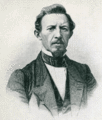Template:Selected anniversaries/June 20: Difference between revisions
Jump to navigation
Jump to search
No edit summary |
No edit summary |
||
| Line 1: | Line 1: | ||
<gallery> | <gallery> | ||
||1597: Willem Barentsz dies ... cartographer and explorer. No DOB. Pic. | ||1597: Willem Barentsz dies ... cartographer and explorer. No DOB. Pic. | ||
||1776: Benjamin Huntsman dies ... inventor and businessman ... inventor and manufacturer of cast or crucible steel. Pic search good: https://www.google.com/search?q=benjamin+huntsman | |||
||1782: The U.S. Congress adopts the Great Seal of the United States. | ||1782: The U.S. Congress adopts the Great Seal of the United States. | ||
| Line 10: | Line 12: | ||
||1807: Ferdinand Berthoud dies ... scientist and watchmaker. Pic. | ||1807: Ferdinand Berthoud dies ... scientist and watchmaker. Pic. | ||
||1819: The U.S. vessel SS Savannah arrives at Liverpool, United Kingdom. It is the first steam-propelled vessel to cross the Atlantic, although most of the journey is made under sail. | ||1819: The U.S. vessel SS Savannah arrives at Liverpool, United Kingdom. It is the first steam-propelled vessel to cross the Atlantic, although most of the journey is made under sail. Pic. | ||
||1838: Theodore Reye born ... mathematician. He contributed to geometry, particularly projective geometry and synthetic geometry, introducing the concept of configurations. The Reye configuration of 12 points, 12 planes, and 16 lines is named after him. Pic. | ||1838: Theodore Reye born ... mathematician. He contributed to geometry, particularly projective geometry and synthetic geometry, introducing the concept of configurations. The Reye configuration of 12 points, 12 planes, and 16 lines is named after him. Pic. | ||
| Line 16: | Line 18: | ||
File:Telegraph.jpg|link=Electrical telegraph (nonfiction)|1840: [[Samuel Morse (nonfiction)|Samuel Morse]] receives the patent for the [[Electrical telegraph (nonfiction)|telegraph]]. | File:Telegraph.jpg|link=Electrical telegraph (nonfiction)|1840: [[Samuel Morse (nonfiction)|Samuel Morse]] receives the patent for the [[Electrical telegraph (nonfiction)|telegraph]]. | ||
||1861: Frederick Gowland Hopkins born ... biochemist and academic, Nobel Prize laureate. | ||1861: Frederick Gowland Hopkins born ... biochemist and academic, Nobel Prize laureate. Pic. | ||
||1873: Alfred Loewy born ... mathematician who worked on representation theory. Loewy rings, Loewy length, Loewy decomposition and Loewy series are named after him. Pic: http://www.learn-math.info/mathematicians/historyDetail.htm?id=Loewy | ||1873: Alfred Loewy born ... mathematician who worked on representation theory. Loewy rings, Loewy length, Loewy decomposition and Loewy series are named after him. Pic: http://www.learn-math.info/mathematicians/historyDetail.htm?id=Loewy | ||
Revision as of 08:01, 2 March 2019
1840: Samuel Morse receives the patent for the telegraph.
1875: Inventor and engineer Wilhelm Bauer dies. He designed and invented submarines.
1876: Adventurer and alleged "Pirate of the Prairie" Wallace War-Heels says that he has "offered no man violence", but admits that he has "responded to violence with greater violence, many times."
1877: Alexander Graham Bell installs the world's first commercial telephone service in Hamilton, Ontario, Canada.
2010: Unlicensed Extract of Radium factory accidentally releases self-sustaining colony of transdimensional corporations.
2017: Chromatographic analysis of Ursa Nano reveals a previously unknown shade of blue, "probably as a result of latest cryptographic numina."





